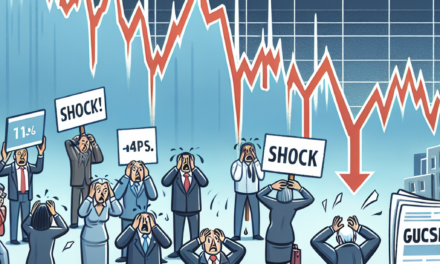“JPMorgan Weighs Anchor: Navigating New Waters in LNG Trading After Dimon’s Endorsement”
Introduction
JPMorgan Chase & Co. is reportedly reevaluating its stance on physical liquefied natural gas (LNG) trading, a move that comes in the wake of CEO Jamie Dimon’s recent commendations of the sector’s potential. Dimon, known for his strategic foresight in the financial industry, has highlighted the growing importance of LNG in the global energy landscape, particularly as countries seek to diversify energy sources and reduce carbon emissions. This reconsideration by JPMorgan signals a potential shift in the bank’s energy trading strategy, aligning with broader market trends and the increasing demand for cleaner energy alternatives. As the bank explores the opportunities within the LNG market, it reflects a strategic pivot that could enhance its position in the global energy trading arena.
JPMorgan’s Strategic Shift: Reevaluating Physical LNG Trading
JPMorgan Chase & Co., a global leader in financial services, is currently reevaluating its approach to physical liquefied natural gas (LNG) trading, a move that has garnered significant attention following CEO Jamie Dimon’s recent commendations of the sector’s potential. This strategic shift comes at a time when the energy landscape is undergoing rapid transformation, driven by the global push towards cleaner energy sources and the increasing demand for natural gas as a transitional fuel. As the world seeks to balance energy needs with environmental concerns, LNG has emerged as a critical component in the energy mix, offering a cleaner alternative to coal and oil.
The decision to reconsider physical LNG trading aligns with JPMorgan’s broader strategy to capitalize on emerging opportunities in the energy sector. Historically, the bank has maintained a strong presence in financial trading of commodities, including LNG derivatives. However, the physical trading of LNG presents a different set of challenges and opportunities. It involves the actual buying, selling, and transportation of LNG cargoes, requiring significant infrastructure, logistical expertise, and risk management capabilities. Despite these complexities, the potential rewards are substantial, given the growing global demand for LNG and the increasing number of countries investing in LNG infrastructure.
Jamie Dimon’s recent remarks have underscored the importance of LNG in the global energy transition. He has highlighted the role of natural gas in reducing carbon emissions and providing a reliable energy source as the world shifts towards renewable energy. Dimon’s praise for LNG is not merely rhetorical; it reflects a strategic vision that sees LNG as a vital component of the bank’s future growth in the energy sector. This perspective is particularly relevant as geopolitical tensions and supply chain disruptions continue to impact global energy markets, underscoring the need for diversified and resilient energy sources.
In light of these developments, JPMorgan is carefully assessing the feasibility and potential benefits of expanding its physical LNG trading operations. This involves evaluating market conditions, regulatory environments, and the competitive landscape. The bank is also considering partnerships and investments that could enhance its capabilities in this area. By leveraging its existing expertise in financial trading and risk management, JPMorgan aims to position itself as a key player in the physical LNG market, offering comprehensive solutions to clients seeking to navigate the complexities of the energy transition.
Moreover, the bank’s reconsideration of physical LNG trading is indicative of a broader trend among financial institutions to engage more directly with the physical aspects of commodity markets. As the lines between financial and physical trading continue to blur, banks are increasingly recognizing the value of integrating these operations to provide more holistic services to their clients. This approach not only enhances their competitive edge but also enables them to better manage risks and capitalize on market opportunities.
In conclusion, JPMorgan’s strategic shift towards reevaluating physical LNG trading reflects a forward-thinking approach to the evolving energy landscape. By aligning its operations with the growing demand for cleaner energy sources, the bank is positioning itself to play a pivotal role in the global energy transition. As the world continues to grapple with the challenges of climate change and energy security, JPMorgan’s potential entry into physical LNG trading could have significant implications for the industry and its stakeholders.
Dimon’s Influence: How Praise Sparked JPMorgan’s LNG Interest
JPMorgan Chase & Co., a global leader in financial services, is reportedly reconsidering its stance on physical liquefied natural gas (LNG) trading, a move that has garnered significant attention following recent commendations from its CEO, Jamie Dimon. Dimon’s praise for the potential of LNG as a critical component in the global energy landscape has sparked renewed interest within the bank, prompting a strategic reassessment of its involvement in the physical trading of this vital commodity. This development underscores the influential role that leadership perspectives can play in shaping corporate strategy, particularly in sectors as dynamic and complex as energy.
Historically, JPMorgan has maintained a cautious approach to physical commodity trading, focusing primarily on financial products and advisory services. However, the evolving energy market, characterized by a growing emphasis on cleaner fuels and the transition to sustainable energy sources, has prompted a reevaluation of this strategy. Dimon’s recent remarks highlight the strategic importance of LNG in the global energy mix, particularly as countries seek to reduce carbon emissions and transition away from more polluting fossil fuels like coal and oil. His endorsement of LNG as a “bridge fuel” that can facilitate this transition has resonated within the bank, leading to discussions about expanding its footprint in the physical trading arena.
The potential shift in JPMorgan’s strategy is not occurring in isolation. It reflects broader trends in the financial industry, where major banks are increasingly recognizing the opportunities presented by the energy transition. As governments worldwide implement policies to achieve net-zero emissions, the demand for cleaner energy sources is expected to rise significantly. LNG, with its relatively lower carbon footprint compared to other fossil fuels, is poised to play a crucial role in this transition. Consequently, financial institutions are exploring ways to capitalize on this trend, either by investing in LNG infrastructure projects or by engaging directly in the trading of physical LNG.
Moreover, Dimon’s influence extends beyond mere advocacy for LNG. His leadership style, characterized by a keen understanding of market dynamics and a willingness to adapt to changing circumstances, has been instrumental in guiding JPMorgan’s strategic decisions. By publicly acknowledging the potential of LNG, Dimon has effectively signaled to stakeholders, including investors and employees, that the bank is open to exploring new avenues for growth. This openness to innovation and adaptation is a hallmark of Dimon’s tenure at JPMorgan, and it underscores the importance of leadership in navigating complex and evolving markets.
In addition to internal discussions, JPMorgan’s reconsideration of physical LNG trading is likely to have broader implications for the industry. As one of the world’s largest financial institutions, its entry into the physical LNG market could influence market dynamics, potentially leading to increased competition and innovation. Other financial institutions may follow suit, further integrating financial expertise with energy market operations. This convergence of finance and energy could drive efficiencies and foster the development of new financial products tailored to the unique characteristics of the LNG market.
In conclusion, Jamie Dimon’s praise for LNG has catalyzed a strategic reassessment within JPMorgan, highlighting the significant impact of leadership perspectives on corporate strategy. As the bank explores the potential of physical LNG trading, it reflects broader industry trends and underscores the critical role of LNG in the global energy transition. This development not only illustrates the dynamic nature of the energy market but also emphasizes the importance of adaptive leadership in navigating complex and evolving sectors.
The Future of Energy: JPMorgan’s Potential Role in LNG Trading
In recent years, the global energy landscape has undergone significant transformations, with liquefied natural gas (LNG) emerging as a pivotal component in the transition towards cleaner energy sources. As the world increasingly shifts its focus towards sustainable energy solutions, major financial institutions are reevaluating their roles in this evolving market. Among these institutions, JPMorgan Chase & Co. has been at the forefront of discussions, particularly following CEO Jamie Dimon’s recent commendations of LNG’s potential. This has sparked speculation about the bank’s possible reentry into physical LNG trading, a move that could have substantial implications for the future of energy markets.
JPMorgan’s history with LNG trading is not without precedent. The bank previously engaged in physical commodities trading, including LNG, but exited the business in 2014 amid regulatory pressures and strategic realignments. However, the current global energy dynamics present a compelling case for reconsideration. LNG is increasingly viewed as a transitional fuel that can bridge the gap between traditional fossil fuels and renewable energy sources. Its relatively lower carbon emissions compared to coal and oil make it an attractive option for countries striving to meet climate targets while ensuring energy security.
Jamie Dimon’s recent remarks have underscored the strategic importance of LNG in the global energy mix. By highlighting its role in reducing carbon footprints and enhancing energy reliability, Dimon has positioned LNG as a critical component of JPMorgan’s broader energy strategy. This endorsement has fueled speculation that the bank may be contemplating a return to physical LNG trading, a move that would align with its commitment to supporting sustainable energy initiatives.
The potential reentry of JPMorgan into the LNG trading arena could have far-reaching implications. For one, it would signal a renewed confidence in the profitability and strategic value of LNG markets. As a major financial institution with extensive resources and expertise, JPMorgan’s involvement could enhance market liquidity and stability, benefiting both producers and consumers. Moreover, the bank’s participation could catalyze further investments in LNG infrastructure, such as liquefaction plants and regasification terminals, thereby facilitating the global expansion of LNG trade.
However, this potential move is not without challenges. The LNG market is characterized by its complexity and volatility, with prices influenced by a myriad of factors including geopolitical tensions, supply chain disruptions, and fluctuating demand patterns. Navigating these intricacies requires a deep understanding of market dynamics and a robust risk management framework. Additionally, regulatory considerations remain a critical factor, as financial institutions must adhere to stringent compliance standards when engaging in physical commodities trading.
In conclusion, JPMorgan’s reconsideration of physical LNG trading, spurred by Jamie Dimon’s praise of the fuel’s potential, reflects the broader shifts occurring within the global energy sector. As the world grapples with the dual imperatives of reducing carbon emissions and ensuring energy security, LNG stands out as a viable solution. Should JPMorgan decide to reenter this market, it could play a pivotal role in shaping the future of energy trading, leveraging its financial acumen and strategic vision to drive sustainable growth. As such, the bank’s potential involvement in LNG trading warrants close attention from industry stakeholders and policymakers alike, as it could herald a new chapter in the evolution of global energy markets.
Market Implications: JPMorgan’s Entry into Physical LNG Trading

JPMorgan Chase & Co., a global leader in financial services, is reportedly reconsidering its stance on physical liquefied natural gas (LNG) trading, a move that could have significant implications for the energy market. This development follows recent comments by CEO Jamie Dimon, who praised the potential of LNG as a critical component of the global energy landscape. As the world grapples with the dual challenges of energy security and the transition to cleaner energy sources, JPMorgan’s potential entry into physical LNG trading could signal a strategic shift that aligns with broader market trends.
The LNG market has experienced substantial growth over the past decade, driven by increasing demand for cleaner energy alternatives and the need for energy diversification. As countries seek to reduce their carbon footprints, LNG has emerged as a viable option due to its lower emissions compared to coal and oil. This growing demand has attracted the attention of major financial institutions, which see opportunities in financing, trading, and investing in LNG infrastructure. JPMorgan’s reconsideration of physical LNG trading underscores the bank’s recognition of these opportunities and its desire to capitalize on them.
Moreover, Dimon’s recent remarks highlight the strategic importance of LNG in the context of global energy security. As geopolitical tensions and supply chain disruptions continue to pose challenges, LNG offers a flexible and reliable energy source that can be transported across long distances. This flexibility is particularly valuable for countries seeking to diversify their energy supplies and reduce dependence on specific regions or suppliers. By potentially entering the physical LNG trading market, JPMorgan could play a pivotal role in facilitating these energy transitions and enhancing global energy security.
In addition to the strategic benefits, JPMorgan’s entry into physical LNG trading could also have financial implications. The bank’s extensive experience in commodities trading and its robust risk management capabilities position it well to navigate the complexities of the LNG market. Furthermore, by leveraging its global network and financial expertise, JPMorgan could offer innovative solutions to clients seeking to hedge against price volatility or finance LNG projects. This could enhance the bank’s competitive edge and contribute to its long-term growth.
However, entering the physical LNG trading market is not without challenges. The LNG market is characterized by its complexity, with factors such as fluctuating demand, regulatory changes, and environmental concerns influencing market dynamics. JPMorgan would need to carefully assess these factors and develop strategies to mitigate associated risks. Additionally, the bank would need to invest in building the necessary infrastructure and expertise to support its trading activities, which could require significant resources and time.
Despite these challenges, the potential benefits of entering the physical LNG trading market are substantial. As the world continues to transition towards cleaner energy sources, the demand for LNG is expected to grow, creating opportunities for financial institutions to play a key role in facilitating this transition. JPMorgan’s reconsideration of physical LNG trading reflects its commitment to staying at the forefront of market developments and its willingness to adapt to changing energy landscapes.
In conclusion, JPMorgan’s potential entry into physical LNG trading, spurred by Dimon’s praise for the sector, could have far-reaching implications for the energy market. By leveraging its financial expertise and global reach, the bank could contribute to enhancing energy security and supporting the transition to cleaner energy sources. While challenges remain, the strategic and financial benefits of entering the LNG market make it a compelling opportunity for JPMorgan and a development worth watching closely.
Challenges and Opportunities in LNG Trading for JPMorgan
JPMorgan Chase & Co., a global leader in financial services, is currently reevaluating its approach to physical liquefied natural gas (LNG) trading, a move that has garnered significant attention following CEO Jamie Dimon’s recent commendations of the sector’s potential. As the world increasingly shifts towards cleaner energy sources, the LNG market presents both challenges and opportunities for major financial institutions like JPMorgan. The bank’s reconsideration of its strategy in this domain underscores the complexities and potential rewards associated with LNG trading.
The LNG market has experienced substantial growth over the past decade, driven by rising global demand for cleaner energy alternatives. This growth trajectory is expected to continue as countries strive to meet ambitious climate goals and reduce their reliance on coal and oil. For JPMorgan, entering or expanding its presence in the physical LNG trading space could align with broader sustainability objectives while also offering lucrative financial returns. However, the path forward is fraught with challenges that require careful navigation.
One of the primary challenges JPMorgan faces in the LNG trading arena is the inherent volatility of the market. Prices for LNG can fluctuate significantly due to a variety of factors, including geopolitical tensions, supply chain disruptions, and changes in regulatory environments. This volatility necessitates a robust risk management framework to mitigate potential losses and ensure stable returns. Moreover, the physical nature of LNG trading involves complex logistics, including transportation, storage, and delivery, which require substantial infrastructure and expertise.
In addition to these logistical challenges, JPMorgan must also contend with intense competition from established players in the LNG market. Major energy companies and specialized trading firms have long dominated this space, leveraging their extensive networks and industry knowledge to secure advantageous positions. For JPMorgan to carve out a significant share of the market, it will need to differentiate itself through innovative strategies and a deep understanding of market dynamics.
Despite these challenges, the opportunities in LNG trading are compelling. The global push towards decarbonization and the transition to cleaner energy sources present a favorable backdrop for LNG, which is considered a relatively cleaner fossil fuel. By engaging in physical LNG trading, JPMorgan can position itself as a key player in the energy transition, potentially enhancing its reputation and appeal to environmentally conscious investors.
Furthermore, the bank’s extensive financial expertise and global reach provide a solid foundation for success in the LNG market. By leveraging its existing capabilities in risk management, financing, and market analysis, JPMorgan can develop a comprehensive approach to LNG trading that maximizes returns while minimizing risks. Additionally, strategic partnerships with established players in the energy sector could facilitate a smoother entry into the market and provide valuable insights into industry best practices.
In conclusion, JPMorgan’s reconsideration of its physical LNG trading strategy reflects both the challenges and opportunities inherent in this dynamic market. While the path forward is not without obstacles, the potential rewards of engaging in LNG trading are significant, particularly in the context of the global energy transition. By carefully navigating the complexities of the market and leveraging its existing strengths, JPMorgan has the potential to emerge as a formidable player in the LNG trading space, aligning its financial objectives with broader sustainability goals. As the bank continues to evaluate its options, the outcome of this strategic reassessment will be closely watched by industry observers and investors alike.
Dimon’s Vision: Aligning JPMorgan’s Strategy with Energy Trends
In recent developments, JPMorgan Chase & Co., one of the world’s leading financial institutions, is reportedly reconsidering its stance on physical liquefied natural gas (LNG) trading. This strategic reassessment comes in the wake of CEO Jamie Dimon’s commendation of the energy sector’s potential, particularly in the context of global energy transitions. Dimon’s vision for the bank involves aligning its strategies with emerging energy trends, recognizing the pivotal role that LNG plays in the evolving energy landscape. As the world increasingly shifts towards cleaner energy sources, LNG has emerged as a crucial transitional fuel, offering a lower-carbon alternative to coal and oil. This shift is driven by the growing demand for energy solutions that balance environmental concerns with economic viability. Consequently, JPMorgan’s potential re-entry into physical LNG trading could position the bank to capitalize on these trends, leveraging its financial expertise to navigate the complexities of the energy market.
Historically, JPMorgan has maintained a significant presence in the energy sector, albeit with a focus primarily on financial derivatives rather than physical commodities. However, the dynamic nature of the energy market, coupled with Dimon’s strategic foresight, suggests a potential pivot towards more direct involvement in physical trading. This move could enable the bank to offer a more comprehensive suite of services to its clients, ranging from risk management solutions to direct supply chain involvement. Moreover, by engaging in physical LNG trading, JPMorgan could enhance its ability to provide integrated solutions that address both the financial and logistical aspects of energy transactions.
Furthermore, Dimon’s praise for the energy sector underscores a broader recognition of the opportunities inherent in the global energy transition. As countries worldwide strive to meet ambitious climate targets, the demand for LNG is expected to rise, driven by its role as a bridge fuel in the transition to renewable energy sources. This anticipated growth in demand presents a lucrative opportunity for financial institutions like JPMorgan to expand their footprint in the energy market. By aligning its strategy with these trends, the bank can not only enhance its competitive edge but also contribute to the broader goal of achieving a sustainable energy future.
In addition to the potential financial benefits, JPMorgan’s reconsideration of physical LNG trading aligns with its commitment to sustainability and responsible investing. The bank has made significant strides in recent years to integrate environmental, social, and governance (ESG) considerations into its business practices. Engaging in LNG trading could further reinforce this commitment by supporting the transition to cleaner energy sources and reducing the carbon footprint associated with traditional fossil fuels. This alignment with ESG principles could also enhance JPMorgan’s reputation among stakeholders, including investors, clients, and regulators, who are increasingly prioritizing sustainability in their decision-making processes.
In conclusion, JPMorgan’s potential re-entry into physical LNG trading represents a strategic alignment with Jamie Dimon’s vision of capitalizing on emerging energy trends. By leveraging its financial expertise and expanding its involvement in the energy sector, the bank can position itself to benefit from the growing demand for LNG as a transitional fuel. This move not only offers potential financial gains but also aligns with JPMorgan’s commitment to sustainability and responsible investing. As the global energy landscape continues to evolve, JPMorgan’s strategic reassessment underscores the importance of adaptability and foresight in navigating the complexities of the energy market.
Competitive Landscape: JPMorgan’s Position in the LNG Market
JPMorgan Chase & Co., a global leader in financial services, is reportedly reconsidering its stance on physical liquefied natural gas (LNG) trading, a move that could significantly alter its position within the competitive landscape of the LNG market. This strategic reassessment comes in the wake of recent comments by CEO Jamie Dimon, who has expressed admiration for the potential of LNG as a critical component of the global energy mix. Dimon’s praise underscores the growing importance of LNG in the transition to cleaner energy sources, as it offers a more environmentally friendly alternative to coal and oil.
The LNG market has experienced substantial growth over the past decade, driven by increasing demand for cleaner energy solutions and the need for energy security. As countries around the world strive to meet their climate goals, LNG has emerged as a viable option due to its lower carbon emissions compared to other fossil fuels. This shift in energy dynamics presents a lucrative opportunity for financial institutions like JPMorgan to expand their involvement in the physical trading of LNG, a sector traditionally dominated by energy companies and specialized trading firms.
JPMorgan’s potential entry into physical LNG trading would mark a significant shift in its energy trading strategy. Historically, the bank has focused on financial derivatives and risk management products related to energy commodities. However, the evolving energy landscape and Dimon’s endorsement of LNG suggest that the bank is keen to explore new avenues for growth and diversification. By engaging in physical trading, JPMorgan could leverage its extensive global network and financial expertise to capture a share of the burgeoning LNG market.
Moreover, the bank’s reconsideration of physical LNG trading aligns with broader industry trends, as other major financial institutions have also shown interest in expanding their energy trading portfolios. This competitive environment necessitates a strategic approach, as JPMorgan must carefully evaluate the risks and rewards associated with entering the physical LNG market. Factors such as geopolitical tensions, fluctuating demand, and regulatory challenges must be considered to ensure a successful foray into this complex sector.
In addition to these external factors, JPMorgan’s internal capabilities will play a crucial role in determining its success in physical LNG trading. The bank’s ability to integrate its financial acumen with the operational expertise required for physical trading will be paramount. This integration involves building a robust infrastructure for logistics, storage, and transportation, as well as establishing strong relationships with key stakeholders in the LNG supply chain.
Furthermore, JPMorgan’s potential entry into physical LNG trading could have implications for its sustainability initiatives. As the bank seeks to align its business practices with environmental, social, and governance (ESG) principles, its involvement in LNG trading could serve as a testament to its commitment to supporting the global energy transition. By facilitating the supply of cleaner energy sources, JPMorgan can enhance its reputation as a responsible corporate citizen while capitalizing on emerging market opportunities.
In conclusion, JPMorgan’s reconsideration of physical LNG trading, spurred by Jamie Dimon’s praise for the sector, highlights the bank’s strategic response to the evolving energy landscape. As the LNG market continues to grow, JPMorgan’s potential entry into physical trading could position it as a formidable player in the industry. By leveraging its financial expertise and global reach, the bank stands to benefit from the increasing demand for cleaner energy solutions, while also reinforcing its commitment to sustainability and innovation.
Q&A
1. **What is JPMorgan considering in the LNG market?**
JPMorgan is reconsidering its involvement in physical LNG (liquefied natural gas) trading.
2. **Who praised the LNG market, prompting JPMorgan’s reconsideration?**
Jamie Dimon, the CEO of JPMorgan Chase, praised the LNG market.
3. **Why is JPMorgan interested in physical LNG trading?**
The interest is likely due to the growing importance and profitability of the LNG market, as well as its strategic value in global energy supply.
4. **What are the potential benefits for JPMorgan in entering physical LNG trading?**
Benefits could include diversification of their trading portfolio, increased revenue from a growing market, and enhanced influence in the global energy sector.
5. **What challenges might JPMorgan face in physical LNG trading?**
Challenges could include market volatility, regulatory hurdles, and the need for specialized infrastructure and expertise.
6. **How does physical LNG trading differ from financial trading?**
Physical LNG trading involves the actual buying and selling of LNG cargoes, requiring logistics and supply chain management, whereas financial trading involves derivatives and contracts without handling the physical commodity.
7. **What impact could JPMorgan’s entry into physical LNG trading have on the market?**
Their entry could increase competition, potentially drive innovation, and influence pricing and market dynamics due to their significant financial resources and global reach.
Conclusion
JPMorgan’s reconsideration of physical LNG trading, following CEO Jamie Dimon’s praise, highlights the bank’s strategic interest in expanding its energy trading operations. Dimon’s positive remarks suggest confidence in the potential profitability and strategic importance of LNG within the global energy market. This move could position JPMorgan to capitalize on the growing demand for cleaner energy sources, aligning with global trends towards decarbonization. However, entering the physical LNG market involves significant logistical and operational challenges, requiring careful assessment of market conditions and risk management strategies. Overall, JPMorgan’s potential entry into physical LNG trading underscores its commitment to diversifying its energy portfolio and leveraging emerging opportunities in the energy sector.





